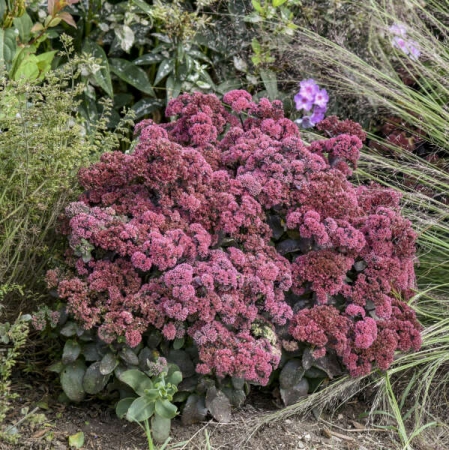Sedum (Stonecrop)
×
Color Name: Midnight Velvet
'Midnight Velvet' adds a unique foliage and flower color combination. Rich, dark purple leaves comprise the domed habit, adding garden interest from the moment they appear in spring. Beginning in late summer clusters of mauve buds cover the habit, before bursting open with rose red flowers. After bloom seedheads appear a dark red color. Leave seedheads standing for seasonal interest and as a food source for birds in winter. UV light is required to see true foliage color; leaves will be more green in too much shade.
Tall, upright sedums form substantial clumps of foliage which can be substituted for shrubs in the landscape. Their stout, sturdy stems support the massive flower heads which develop in summer and burst into bloom in fall. If left standing, they provide winter interest and food for birds.
Growing Tips: Sedum is one of the most popular perennials grown in American gardens because it is very easy to grow and hardy in most areas of the country. Because of its thick, succulent leaves which can store water, sedum is drought tolerant. It should be sited in average to poor soil that is well-drained. Plants grown in rich soil tend to be lanky and open. Most varieties should be grown in full sun to light shade. The lower growing types, however, will survive in partial shade. This plant is not usually bothered by pests or diseases. The seed heads of the taller varieties provide excellent winter interest and food for birds. Remove them in spring when the new growth begins to show.
Photo courtesy of Walters Garden, Inc.
'Midnight Velvet' adds a unique foliage and flower color combination. Rich, dark purple leaves comprise the domed habit, adding garden interest from the moment they appear in spring. Beginning in late summer clusters of mauve buds cover the habit, before bursting open with rose red flowers. After bloom seedheads appear a dark red color. Leave seedheads standing for seasonal interest and as a food source for birds in winter. UV light is required to see true foliage color; leaves will be more green in too much shade.
Tall, upright sedums form substantial clumps of foliage which can be substituted for shrubs in the landscape. Their stout, sturdy stems support the massive flower heads which develop in summer and burst into bloom in fall. If left standing, they provide winter interest and food for birds.
Growing Tips: Sedum is one of the most popular perennials grown in American gardens because it is very easy to grow and hardy in most areas of the country. Because of its thick, succulent leaves which can store water, sedum is drought tolerant. It should be sited in average to poor soil that is well-drained. Plants grown in rich soil tend to be lanky and open. Most varieties should be grown in full sun to light shade. The lower growing types, however, will survive in partial shade. This plant is not usually bothered by pests or diseases. The seed heads of the taller varieties provide excellent winter interest and food for birds. Remove them in spring when the new growth begins to show.
Photo courtesy of Walters Garden, Inc.
|
Flower Color: Pink/Red Shades Foliage Color: Black/Purple Shades
Height: 22 to 26 Inches Spread: 30 to 34 Inches Hardy in Zone: 5, 6 |
Blooms: Fall Late Summer
Foliage Season: All season |
Growth Rate |
Medium
|
Attributes |
Container Dried Flower Border Cut Flower or Foilage Drought Tolerant Easy to Grow Landscapes Mass Planting Salt Tolerant
|








